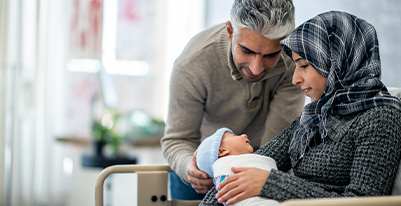Our Team
The Team Caring For Your Baby
Many professionals work together to care for premature or sick babies. You may meet some or all of the following: neonatologists, pediatric hospitalists, registered nurses, respiratory therapists, social workers, physical therapists, occupational therapists, speech and language specialists, unit secretaries, and nurse aides. Many professionals work together to care for premature or sick babies.
What is a Neonatologist?
A Neonatologist is trained specifically to handle the most complex and high-risk situations. If your newborn is premature, or has a serious illness, injury, or birth defect, a neonatologist may assist at the time of delivery and in the subsequent care of your newborn. If a problem is identified before your baby is born, a neonatologist may become involved to consult with your obstetrician in your baby's care during your pregnancy. Neonatologists generally provide the following care:
- Diagnose and treat newborns with conditions such as breathing disorders, infections, and birth defects.
- Coordinate care and medically manage newborns born premature, critically ill, or in need of surgery.
- Ensure that critically ill newborns receive the proper nutrition for healing and growth.
- Provide care to the newborn at a cesarean or other delivery that involves medical problems in the mother or baby that may compromise the infant's health and require medical intervention in the delivery room.
Information provided by the American Academy of Pediatrics.
What is a Pediatric Hospitalist?
A pediatric hospitalist is a pediatrician who specializes in caring for children while they are in the hospital. This person works with your child's regular pediatrician throughout your child's stay and provides them with instructions on any follow-up care.
What is a Neonatal Nurse?
Neonatal nurses are registered nurses with additional training allowing them to specialize in the care of newborn infants.
What You Will See and Hear
Your nurse will explain what equipment your baby is using and what each of the alarms you may hear means. Ask questions – we want you to feel safe, comfortable and informed.
The NICU contains many machines and other types of equipment used to care for sick babies with many different problems. These machines seem less intimidating when you understand how they can help your baby.
- Bili lights: The bright blue fluorescent lights placed over the baby are used to treat jaundice (yellowing of the skin and eyes). Babies with jaundice usually receive the "phototherapy" treatment for three to seven days.
- Blood pressure monitor: A machine connected to a small blood pressure cuff wrapped around your baby's arm or leg. The cuff automatically takes your baby's blood pressure at regular times and displays the numbers on a screen.
- Cardiopulmonary monitor: A machine that tracks your baby's heart and breathing rates. It is connected to your baby by small adhesive monitoring pads placed on her chest. If your baby's heart rate or breathing rate becomes too fast or too slow, an alarm will sound.
- Central line: An intravenous line inserted into a vein, in the arm or leg, and leads into a larger vein in the body close to the heart. The line delivers medicines or nutritional solutions. A PICC (peripherally inserted central catheter) is a type of central line, which is placed in one of the major blood vessels.
- C-PAP (continuous positive airway pressure): Air is delivered to a baby's lungs either through small tubes in the baby's nose or through a tube that has been inserted into their windpipe. The tubes are attached to a mechanical ventilator, which helps the baby breathe, but does not breathe for them.
- Endotracheal tube: A small plastic tube, which is inserted through a baby's mouth down into the trachea (windpipe). The tube is attached to a mechanical ventilator, which can help a baby to breathe.
- Isolette: Babies are placed in this clear plastic box, which keeps them warm and protects them from germs and noise.
- Intravenous line: Most premature and sick babies cannot be fed immediately, so they must receive nutrients and fluids intravenously (through a vein). A doctor or nurse will insert a very small needle or tube into a tiny vein in the baby's hand, foot, arm, leg or scalp. Your baby also can receive medications and blood through the IV line.
- Mechanical ventilator: A mechanical ventilator is a breathing machine that delivers warmed and humidified air to a baby's lungs. The sickest babies receive mechanical ventilation, meaning that the mechanical ventilator temporarily breathes for them while their lungs recover. The amount of oxygen, air pressure and number of breaths per minute can be regulated to meet each baby's needs.
- Nasal cannula or nasal prongs: Small plastic tubes that fit into your baby's nostrils and deliver oxygen.
- Oxygen hood: A clear plastic box that fits over the baby's head and supplies him with oxygen.
- Pulse oximeter: A small device that is wrapped around a baby's foot or hand and secured with a stretchy bandage. It uses a light sensor to help determine if the baby has enough oxygen in her blood.
- Radiant warmer: An open bed with an overhead heating that provides heat to a baby. A warmer may be used instead of an isolette if the baby needs to be handled frequently.
- Umbilical catheter: A thin tube (catheter) inserted into the umbilicus. Through this catheter, doctors and nurses can painlessly draw blood. They don't have to repeatedly stick the baby with needles. They can give fluids, blood, nutrients and medications through this tube. A small device can be attached to the catheter to continuously monitor your baby's blood pressure.
